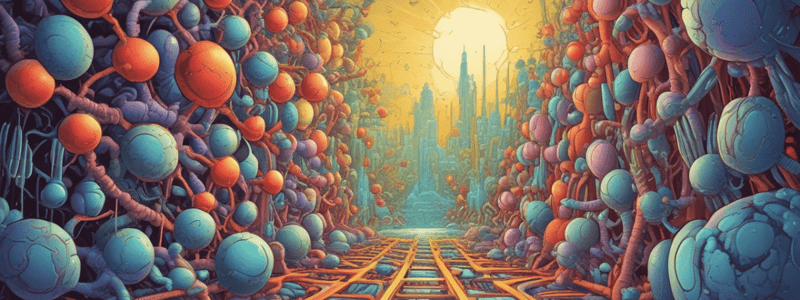Podcast
Questions and Answers
What is the dimerization pattern of Class II Nuclear Receptors?
What is the dimerization pattern of Class II Nuclear Receptors?
- Homo- or heterodimer
- Heterodimer with RXR (correct)
- Monomer
- Homodimer
Steroid hormone nuclear receptors bind to inverted repeat response elements.
Steroid hormone nuclear receptors bind to inverted repeat response elements.
True (A)
What is the typical location of nuclear receptors that are not bound to ligands?
What is the typical location of nuclear receptors that are not bound to ligands?
Cytoplasm
The direct repeat response element typically has a _______ base pair spacer.
The direct repeat response element typically has a _______ base pair spacer.
Match the following types of nuclear receptors with their characteristic ligands:
Match the following types of nuclear receptors with their characteristic ligands:
What is the response element pattern for Class I Nuclear Receptors?
What is the response element pattern for Class I Nuclear Receptors?
Monomeric orphan nuclear receptors display constitutive activity.
Monomeric orphan nuclear receptors display constitutive activity.
What is the function of the first zinc finger in the DNA binding domain of a nuclear receptor?
What is the function of the first zinc finger in the DNA binding domain of a nuclear receptor?
The N-terminal domain of a nuclear receptor is highly conserved.
The N-terminal domain of a nuclear receptor is highly conserved.
What is the function of the activation function 1 (AF1) in a nuclear receptor?
What is the function of the activation function 1 (AF1) in a nuclear receptor?
The two zinc fingers in the DNA binding domain of a nuclear receptor are formed by __________ loops.
The two zinc fingers in the DNA binding domain of a nuclear receptor are formed by __________ loops.
Match the following parts of a nuclear receptor with their functions:
Match the following parts of a nuclear receptor with their functions:
What is the common number of base pairs in the spacer region of a nuclear receptor response element?
What is the common number of base pairs in the spacer region of a nuclear receptor response element?
The second zinc finger in the DNA binding domain of a nuclear receptor is involved in receptor dimerization.
The second zinc finger in the DNA binding domain of a nuclear receptor is involved in receptor dimerization.
What is the function of nuclear receptors after binding a ligand intracellularly?
What is the function of nuclear receptors after binding a ligand intracellularly?
Retinoid X receptor (RXR) forms homodimers to activate gene transcription.
Retinoid X receptor (RXR) forms homodimers to activate gene transcription.
What are the two xenobiotic receptors mentioned in the text that are involved in the regulation of CYP expression?
What are the two xenobiotic receptors mentioned in the text that are involved in the regulation of CYP expression?
Nuclear receptors are classified into ______________________ subfamilies.
Nuclear receptors are classified into ______________________ subfamilies.
Match the following nuclear receptors with their functions:
Match the following nuclear receptors with their functions:
Cofactors are required for the interaction of nuclear receptors with DNA.
Cofactors are required for the interaction of nuclear receptors with DNA.
What is the result of xenobiotics binding to xenobiotic receptors?
What is the result of xenobiotics binding to xenobiotic receptors?
What is the main function of glucocorticoids (GCs)?
What is the main function of glucocorticoids (GCs)?
The glucocorticoid receptor (GR) is a type of transcription factor.
The glucocorticoid receptor (GR) is a type of transcription factor.
What is the result of ligand binding to the glucocorticoid receptor?
What is the result of ligand binding to the glucocorticoid receptor?
The glucocorticoid receptor binds to the ______ response element (GRE) to increase gene transcription.
The glucocorticoid receptor binds to the ______ response element (GRE) to increase gene transcription.
Match the following peroxisome proliferator-activated receptors (PPARs) with their primary functions:
Match the following peroxisome proliferator-activated receptors (PPARs) with their primary functions:
What is the effect of GR binding to negative GRE?
What is the effect of GR binding to negative GRE?
The glucocorticoid receptor can bind to DNA as a monomer.
The glucocorticoid receptor can bind to DNA as a monomer.
The glucocorticoid receptor interacts with ______ to inhibit gene transcription.
The glucocorticoid receptor interacts with ______ to inhibit gene transcription.
What is the difference between non-permissive and permissive RXR heterodimers?
What is the difference between non-permissive and permissive RXR heterodimers?
What is the result of chronic use of glucocorticoids?
What is the result of chronic use of glucocorticoids?
Glucocorticoids are involved in immune system enhancement.
Glucocorticoids are involved in immune system enhancement.
What is the role of the hinge region in the glucocorticoid receptor?
What is the role of the hinge region in the glucocorticoid receptor?
The glucocorticoid receptor is encoded by the NR3C1 gene through ______________________.
The glucocorticoid receptor is encoded by the NR3C1 gene through ______________________.
What happens to the glucocorticoid receptor upon ligand binding?
What happens to the glucocorticoid receptor upon ligand binding?
Match the following domains of the glucocorticoid receptor with their functions:
Match the following domains of the glucocorticoid receptor with their functions:
Glucocorticoids are involved in maintaining homeostasis and responding to stress.
Glucocorticoids are involved in maintaining homeostasis and responding to stress.
What is the ligand for Steroid NR?
What is the ligand for Steroid NR?
Nuclear receptors undergo dimerisation.
Nuclear receptors undergo dimerisation.
What is the response element pattern for Steroid NR?
What is the response element pattern for Steroid NR?
RXR forms a ______________ with other nuclear receptors.
RXR forms a ______________ with other nuclear receptors.
What is the location of RXR?
What is the location of RXR?
Match the following nuclear receptors with their characteristic ligands:
Match the following nuclear receptors with their characteristic ligands:
What are the two xenobiotic receptors mentioned in the text?
What are the two xenobiotic receptors mentioned in the text?
What is the characteristic of a Non-permissive RXR heterodimer?
What is the characteristic of a Non-permissive RXR heterodimer?
PPARy can be activated without ligand in normal circumstances.
PPARy can be activated without ligand in normal circumstances.
What is the function of PPARy in adipocyte differentiation and mature adipocyte function?
What is the function of PPARy in adipocyte differentiation and mature adipocyte function?
PPARy forms a ______________ with RXR.
PPARy forms a ______________ with RXR.
Match the following PPARs with their primary functions:
Match the following PPARs with their primary functions:
FGF1 blocks _______ of PPARy.
FGF1 blocks _______ of PPARy.
RXR forms homodimers to activate gene transcription.
RXR forms homodimers to activate gene transcription.
What is the role of the first zinc finger in the DNA binding domain of a nuclear receptor?
What is the role of the first zinc finger in the DNA binding domain of a nuclear receptor?
The hinge region in nuclear receptors is highly conserved
The hinge region in nuclear receptors is highly conserved
What is the function of helix 12 in the ligand binding domain of a nuclear receptor?
What is the function of helix 12 in the ligand binding domain of a nuclear receptor?
The ligand binding domain (LBD) of a nuclear receptor forms a ______ pocket formed by 2 α-helices
The ligand binding domain (LBD) of a nuclear receptor forms a ______ pocket formed by 2 α-helices
Match the following regions of a nuclear receptor with their functions:
Match the following regions of a nuclear receptor with their functions:
What is the function of Activation Function 2 (AF2) in a nuclear receptor?
What is the function of Activation Function 2 (AF2) in a nuclear receptor?
Post-translational modifications occur in the ligand binding domain of a nuclear receptor
Post-translational modifications occur in the ligand binding domain of a nuclear receptor
The second zinc finger in the DNA binding domain of a nuclear receptor is involved in ______
The second zinc finger in the DNA binding domain of a nuclear receptor is involved in ______
What is the function of the hinge region in allowing flexibility for conformational change after ligand binding?
What is the function of the hinge region in allowing flexibility for conformational change after ligand binding?
Study Notes
Nuclear Receptors
- 48 nuclear receptors (NRs) are ligand-activated transcription factors that bind a ligand intracellularly and interact with DNA directly via recognition of response elements
- Classified into seven subfamilies
Classification of Nuclear Receptors
- Steroid Hormone NRs: e.g., glucocorticoid, estrogen; ligand; receptor homodimer; response element: inverted repeat (IR) or direct repeat (DR)
- RXR Heterodimers: e.g., fatty acids, retinoic acids, cholesterol; ligand; receptor heterodimer; response element: direct repeat (DR)
- Dimeric Orphan NRs: unknown ligand; receptor homo- or hetero-dimer; response element: direct repeat (DR)
- Monomeric Orphan NRs: unknown ligand; receptor monomer; response element: binds to one extended response element half-site
Structure of a Nuclear Receptor
- N-terminal Domain (A/B): least conserved, varies in length and amino acid sequence; activation function 1 (AF1); post-translational modifications
- DBD (DNA Binding Domain, C): highly conserved, responsible for DNA recognition and binding; two zinc fingers formed by cysteine-rich loops
- Hinge Region (D): o NLS1 overlaps with the end of DBD and the hinge region, o NLS2 overlaps with the LBD
- Ligand Binding Domain (E/F): binds ligand
The HPA Axis, Glucocorticoids, and Receptors
- The HPA Axis: release of glucocorticoids (cortisol in humans); negative feedback mechanisms
- Glucocorticoids: maintain homeostasis and respond to stress; regulate metabolic and immune responses; anti-inflammatory and immunosuppressive
- Glucocorticoid Receptor (GR): encoded by the NR3C1 gene; alternative splicing of exon 9 → GRα and GRβ; GRγ contains an arginine insertion in the DBD
The Glucocorticoid Receptor
- N-terminal Domain (A/B): multiple post-translational modification sites
- DNA Binding Domain (C): binds to specific hormone response elements (HREs)
- Hinge Region (D): overlaps with the end of DBD and the hinge region
- Ligand Binding Domain (E/F): binds ligand
GR-mediated Signaling
- Unliganded GR: resides in the cytoplasm, forms a complex with HSP90 and other chaperone proteins
- Ligand Binding: GR dissociates from the complex, exposes nuclear localization signals, and is translocated into the nucleus
GR-mediated Regulation of Gene Transcription
- Direct Binding: GR dimer binds to GRE (GGAACAnnnTGTTCT) → ↑ gene transcription
- Transrepression: GR binds to negative GRE (IR nGRE, CTCC(n)0-2GGAGA) → ↓ gene transcription
- Tethering: GR binds directly to DNA-bound AP-1 or NF-κB
- Composite: GRE-bound GR interacts with neighboring DNA-bound AP-1 or NF-κB
Class II NR - RXR Heterodimers
- Non-permissive RXR Heterodimer: e.g., thyroid hormone receptor or vitamin D receptor; heterodimer is activated by ligands of the partner NR, while RXR is silenced
- Permissive RXR Heterodimer: e.g., peroxisome proliferator-activated receptor; heterodimer is activated by ligands of either NR, with synergistic effects when both NRs are activated
Nuclear Receptors
- Nuclear receptors are ligand-activated transcription factors with 7 subfamilies and 48 members.
- They dimerize, bind DNA, and have an intracellular ligand-binding domain.
- They act directly with DNA via recognition of response elements.
Classification of Nuclear Receptors
- Steroid nuclear receptors: ligand is glucocorticoid or estrogen, forms homodimers, and response element is INVERTED repeat.
- RXR heterodimer: ligand is fatty acids, retinoic acids, or cholesterol, forms heterodimers, and response element is DIRECT repeat.
- Dimeric orphan nuclear receptors: no known ligand, forms dimers.
- Monomeric orphan nuclear receptors: no known ligand, acts as a monomer.
Structure of a Nuclear Receptor
- N-terminal domain (A/B): least conserved, varies in length and amino acid sequence, and has activation function 1 (AF1).
- DNA binding domain (C): highly conserved, responsible for DNA recognition and binding, and has two zinc fingers formed by cysteine-rich loops.
- Hinge region (D): links DBD and LBD, contains nuclear localization signal (NLS), and allows flexibility for conformational change after ligand binding.
- Ligand binding domain (E/F): highly conserved, has a hydrophobic pocket formed by two α-helices, and has activation function 2 (AF2).
Peroxisome Proliferator-Activated Receptors (PPARs)
- PPARα: expressed in liver, heart, and brown adipose tissue, involved in fatty acid oxidation.
- PPARβ/δ: ubiquitously expressed, involved in fatty acid oxidation.
- PPARγ: expressed in white and brown adipose tissue, involved in adipogenesis, lipid metabolism, and insulin sensitivity.
- PPARγ function: adipocyte differentiation, lipid metabolism, glucose homeostasis, and can be activated without ligand in extreme circumstances.
Glucocorticoid Receptor (GR)
- Maintains homeostasis, responds to stress, regulates metabolism and immune responses, and has anti-inflammatory and immunosuppressive effects.
- GR has a negative feedback mechanism, and chronic use of glucocorticoids can lead to adrenal suppression.
- GR is encoded by the NR3C1 gene, which undergoes alternative splicing to form GRα and GRβ.
- GRα mediates the action of glucocorticoids, while GRβ contains an arginine insertion in the DBD.
GR Signaling
- Unliganded GR is a monomer that resides in the cytoplasm and forms a complex with HSP90 and other chaperone proteins.
- Ligand binding leads to GR dissociation from the complex, exposure of nuclear localization signals, and translocation to the nucleus.
- GR signaling involves kinases and non-genomic effects.
Studying That Suits You
Use AI to generate personalized quizzes and flashcards to suit your learning preferences.
Description
Explore the core concepts of pharmacology, including nuclear receptors, drug response, and patient outcomes. Learn about the structure and function of nuclear receptors and their response elements.




